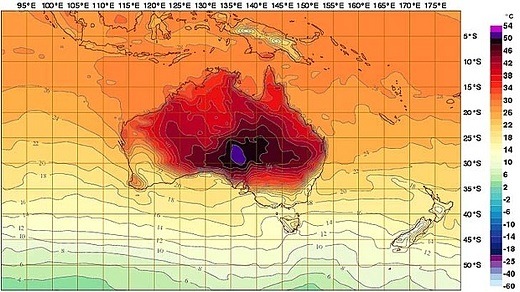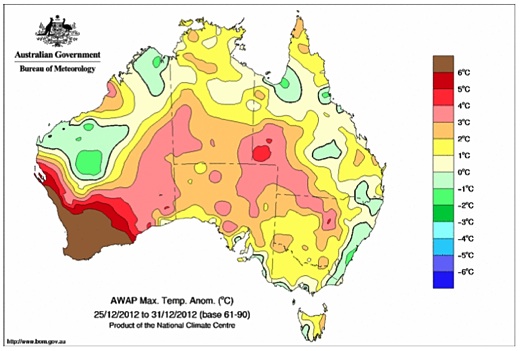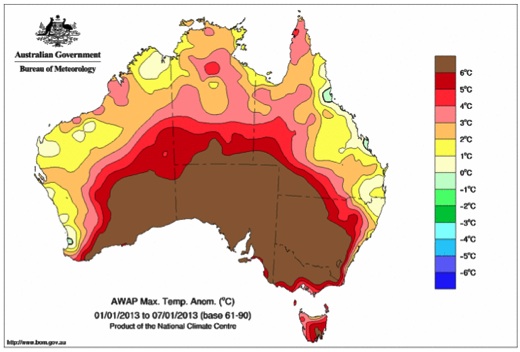SUBHEAD: Australian Bureau of Meteorology adds a new color to map - Burning deep purple is up to 130ºF.
By Jon Queally on 8 January 2013 for Common Dreams -
(http://www.commondreams.org/headline/2013/01/08)

Image above: The new deep purple color was added to maps to designate temperatures to 54ºC (130ºF).From original article.
Wild fires continue to rage across Australia Tuesday and temperatures have become so hot the country's Bureau of Meteorology was forced to add a new color—deep purple—to show areas that have exceeded all-time heat records.
Previously the Bureau's heat index was capped at 48°C (118.4°F), but now recorded temperatures of over 50°C (122°F) have pushed the limit of the scale to an unheard of 54°C, which is equivalent to 129°F.
"The scale has just been increased today and I would anticipate it is because the forecast coming from the bureau's model is showing temperatures in excess of 50 degrees," David Jones, head of the bureau's climate monitoring and prediction unit, told reporters.
Indicating that the worst may yet to come, Jones added that, "The air mass over the inland is still heating up - it hasn't peaked."
Climate scientists in Australia—with Jones among them—say the fires and the heat are unprecedented in scale and intensity, but that Australians should understand the destructive temperatures and ensuing fires across Tasmania and southern sections of the country are the new normal of runaway climate change.
‘The current heatwave – in terms of its duration, its intensity and its extent – is now unprecedented in our records,’’ Jones was quoted as saying in The Age.
‘‘Clearly, the climate system is responding to the background warming trend. Everything that happens in the climate system now is taking place on a planet which is a degree hotter than it used to be.’’
“Those of us who spend our days trawling – and contributing to – the scientific literature on climate change are becoming increasingly gloomy about the future of human civilization,’’ Liz Hanna, convener of the human health division at the Australian National University’s Climate Change Adaptation Network, told The Age in a separate interview.
‘‘We are well past the time of niceties, of avoiding the dire nature of what is unfolding, and politely trying not to scare the public," she said. "The unparalleled setting of new heat extremes is forcing the continual upwards trending of warming predictions for the future, and the timescale is contracting.’’
Responding to the news from Australia, The Guardian's Damian Carrington put the heat and fires in a global context:

Image above: Temperatures in Australia in the last week of 2012. From original article.

Image above: Temperatures in Australia in the first week of 2013. From original article.
.
By Jon Queally on 8 January 2013 for Common Dreams -
(http://www.commondreams.org/headline/2013/01/08)

Image above: The new deep purple color was added to maps to designate temperatures to 54ºC (130ºF).From original article.
Wild fires continue to rage across Australia Tuesday and temperatures have become so hot the country's Bureau of Meteorology was forced to add a new color—deep purple—to show areas that have exceeded all-time heat records.
Previously the Bureau's heat index was capped at 48°C (118.4°F), but now recorded temperatures of over 50°C (122°F) have pushed the limit of the scale to an unheard of 54°C, which is equivalent to 129°F.
"The scale has just been increased today and I would anticipate it is because the forecast coming from the bureau's model is showing temperatures in excess of 50 degrees," David Jones, head of the bureau's climate monitoring and prediction unit, told reporters.
Indicating that the worst may yet to come, Jones added that, "The air mass over the inland is still heating up - it hasn't peaked."
Climate scientists in Australia—with Jones among them—say the fires and the heat are unprecedented in scale and intensity, but that Australians should understand the destructive temperatures and ensuing fires across Tasmania and southern sections of the country are the new normal of runaway climate change.
‘The current heatwave – in terms of its duration, its intensity and its extent – is now unprecedented in our records,’’ Jones was quoted as saying in The Age.
‘‘Clearly, the climate system is responding to the background warming trend. Everything that happens in the climate system now is taking place on a planet which is a degree hotter than it used to be.’’
“Those of us who spend our days trawling – and contributing to – the scientific literature on climate change are becoming increasingly gloomy about the future of human civilization,’’ Liz Hanna, convener of the human health division at the Australian National University’s Climate Change Adaptation Network, told The Age in a separate interview.
‘‘We are well past the time of niceties, of avoiding the dire nature of what is unfolding, and politely trying not to scare the public," she said. "The unparalleled setting of new heat extremes is forcing the continual upwards trending of warming predictions for the future, and the timescale is contracting.’’
Responding to the news from Australia, The Guardian's Damian Carrington put the heat and fires in a global context:
We already know that climate change is loading the weather dice. Scientists have shown that the European heatwave of 2003, that caused over 40,000 premature deaths, was made at least twice as likely by climate change. The Russian heatwave of 2010, that killed 50,000 and wiped out $15bn of crops, was made three times as likely by global warming and led to the warmest European summer for 500 years.
The extreme weather forecast is even worse. Mega-heatwaves like these will become five to 10 times more likely over the next 40 years, occurring at least once a decade, scientists predict.
Work by the most authoritative group of scientists, the UN's Intergovernmental Panel on Climate Change, found that it is 90% certain that heatwaves will increase further in length and severity, as will extreme high tides. It is 66% likely that hurricanes and typhoon winds will get faster and that intense rain will increase, as well as landslides. It is more likely than not that droughts will intensify in Europe, North and Central America and, most dangerously given the poverty there, Southern Africa. There are uncertainties of course, but the basic physics is that heat-trapping carbon emissions mean more energy is being pumped into the system, increasing climate chaos.
The two nations in which the fringe opinions of so-called climate sceptics have been trumpeted most loudly - the US and Australia - have now been hit by record heatwaves and, in the US, superstorm Sandy. The scientists are turning up the volume of their warnings, but whether this leads to loud and clear political action to curb emissions or more shouting from sceptics and the vested fossil fuel interests that support them remains to be seen.According to the special bulletin (pdf) on the record heatwave from Australia's Bureau of Meteorology:
A particular feature of this heatwave event has been the exceptional spatial extent of high temperatures. The table below gives the national and state/territory average maximum temperature for each day of the heatwave event. Australia set a new record for the highest national area-average temperature, recording 40.33 °C and surpassing the previous record set on 21 December 1972 (40.17 °C). To date (data up to the 7 January 2013) the national area-average for each of the first 7 days of 2013 has been in the top 20 hottest days on record, with 6 January the fifth hottest on record and the first time 6 consecutive days over 39 °C has ever been recorded for Australia.

Image above: Temperatures in Australia in the last week of 2012. From original article.

Image above: Temperatures in Australia in the first week of 2013. From original article.
.
No comments :
Post a Comment